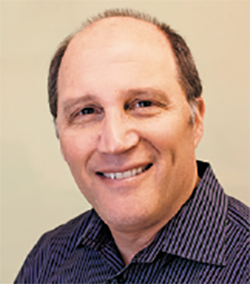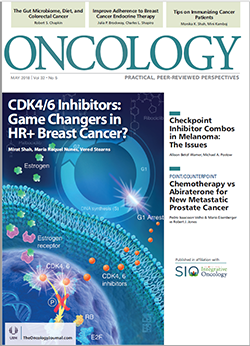Robert Chapkin on Relationships Between the Gut Microbiome, Diet, and Colorectal Cancer
In this Q&A, we discuss the research into the relationships between gut microbiota, diet, and colorectal cancer.
Oncology (Williston Park). 32(5):248-9.

Robert S. Chapkin, MSc, PhD

We have become very familiar with reports in the media comparing the health effects of Western diets, typically heavy in animal fats and proteins, with Asian and Mediterranean diets, which include more fish and place greater emphasis on consumption of fruits, vegetables, and whole grains. There is a growing body of evidence that bioactive molecules derived from pesco-vegetarian meals offer better protection against colorectal cancer than meat-based diets. More recent research has delved even deeper into the beneficial and detrimental effects of dietary components at the molecular level-examining how what we eat and drink influences the quantity and diversity of gut bacteria, and, in turn, evaluating the ways in which the gut microbiota may impact colorectal cancer risk. ONCOLOGY recently interviewed cell biologist and nutritional biochemist Robert Chapkin, MSc, PhD, Distinguished Professor and Allen Endowed Chair in Nutrition & Chronic Disease Prevention in the department of nutrition and food science at Texas A&M University in College Station, Texas, to discuss both his work and the current state of the science in this pioneering area of cancer research.
1.Could you please provide some background on the beginnings of research into the relationship between gut microbiota and colon cancer? What are one or two pivotal studies in this area?
DR. CHAPKIN: Only recently has it been appreciated that intestinal microbiota influences the development of colorectal tumors in preclinical models and human subjects. There have been many studies highlighting the interplay between host genetics, gut microbes, and intestinal tumor initiation/progression. However, the seminal works of Arthur,[1] Tao,[2] and O’Keefe[3] stand out in my mind.
The Arthur laboratory findings provided novel insight into the complex effects of inflammation on microbial composition/activity and the host’s (intestinal mucosa) ability to protect itself from microorganisms with genotoxic capabilities. Also, from a mechanistic perspective, the Tao lab findings demonstrated that Frizzled proteins (receptors that regulate Wnt signaling, required for colonic stem cell maintenance, self-renewal, and repair of the epithelial lining) can be activated by toxin B produced by pathogenic bacteria (Clostridium difficile). These findings demonstrate that colonic stem cells are the target of some microbial toxins. Lastly, the O’Keefe lab findings demonstrated that dietary fiber and fat content have a remarkable effect on the colonic microbiota and its metabolic activity in high-risk vs low-risk cancer populations. His work supports the claim that total fiber intake needs to exceed 50 g per day to prevent colon cancer.
2. What key principles (eg, inflammation) or hypothesis models (eg, bacterial driver/passenger or keystone/pathogen models) are important to understanding how the gut microbiome modulates intestinal cells, immune cells, and malignant cells in the gut?
DR. CHAPKIN: There is ample evidence that the microbiome (eg, patchy bacterial biofilms) in the gut can modulate host immune cell function, promoting low-grade chronic inflammation. This, combined with intestinal barrier deterioration induced by (1) colorectal cancer–initiating genetic lesions, and (2) crosstalk between microbiota and diets low in fiber, results in the invasion of secreted microbial products (eg, oncotoxins), which can drive tumor growth. Intriguingly, the protective effects of dietary fiber on cancer development may be based on dramatic shifts in microbial community function-particularly short-chain fatty acid production-which stimulate gut mucosal metabolism and increase epithelial barrier function. These findings suggest that precision (personalized) nutrition might be utilized to favorably modulate an individual’s microbiota to reduce cancer risk.
3. A review you coauthored in Seminars in Cancer Biology cites studies showing that some microbiota produce DNA-damaging toxins, and that others are known to activate tumor-promoting pathways.[4] You describe multiple “omics” techniques and analyses that could shed light on targetable microbiota/microenvironment interactions of potential use in colorectal cancer prevention and treatment. Could you please highlight two or three of the more promising approaches?
DR. CHAPKIN: A major gap in the field lies in the methodological limitations of assessing the multivariate relationships among the microbial metagenome (DNA), metatranscriptome (messenger RNA), metametabolome (small molecules), and the host transcriptome and metabolome in the gut over time. Our collaborative interdisciplinary team, made up of biologists, engineers, bioinformaticians, and clinician scientists, is developing novel latent variable Bayesian data fusion and network-based algorithms to predict disease risk. The goal is to establish “molecular fingerprints,” which is a first step in identifying host/microbial targets that are amenable to interventions to optimize health and reduce the risk of chronic sequelae of inflammation and cancer.
4. Even your earliest undergraduate and graduate work in the early to mid 1980s was focused on cell biology and nutrition. Could you please share with our readers what drew you to this fascinating field of study?
DR. CHAPKIN: I have always been interested in using cutting-edge experimental tools to determine how and why nutrition, or diet, modifies disease risk. Since only a small fraction of biomedical research funding is devoted to the generation of new knowledge related to cancer prevention, my lab has always had to push the mechanistic boundaries of dietary chemoprevention. Fortunately, our interest in the (1) synergistic effects of systemic and lumenal metabolites on intestinal stem cells, (2) development of a novel noninvasive methodology using exfoliated cells (exfoliome) to monitor host/microbe interactions, (3) effects of dietary/microbial bioactives on plasma membrane structure and function, and (4) investigation of the role of dietary and microbial ligands as modifiers of inflammation and colon cancer development, has been well received by the scientific community.
Financial Disclosure: The author has no significant financial interest in or other relationship with the manufacturer of any product or provider of any service mentioned in this article.
References:
1. Arthur JC, Perez-Chanona E, Mühlbauer M, et al. Intestinal inflammation targets cancer-inducing activity of the microbiota. Science. 2012;338:120-3.
2. Tao L, Zhang J, Meraner P, et al. Frizzled proteins are colonic epithelial receptors for C. difficile toxin B. Nature. 2016;538:350-5.
3. O’Keefe SJ, Li JV, Lahti L, et al. Fat, fibre and cancer risk in African Americans and rural Africans. Nat Commun. 2015;6:6342.
4. Seidel DV, Azcárate-Peril MA, Chapkin RS, Turner ND. Shaping functional gut microbiota using dietary bioactives to reduce colon cancer risk. Semin Cancer Biol. 2017;46:191-204.
